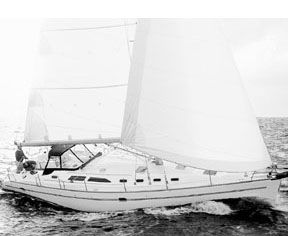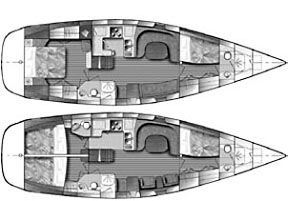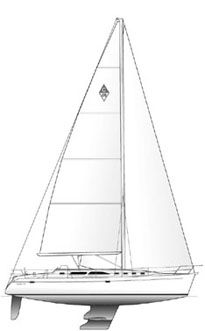We’ve been soaked to the bone while racing Catalina’s most popular model, a 27-footer on which we crewed in a San Francisco one-design fleet. We’ve raced down the Baja coast steering a squirrelly 38-footer under a masthead kite while winning class honors in the Newport-Ensenada race. Over the years, we’ve sailed and reviewed quite a few Catalinas, and have noted two central characteristics of these boats: They have a pretty good turn of speed and spacious accommodations. We’ve also noted that the company’s mass production techniques occasionally reflect a lack of attention to detail in the fit and finish of joinery.
It has also been impossible to miss the fact that Catalina owners are a ferociously loyal lot who tend to shrug off minor shortcomings by saying “Hey, it ain’t supposed to be a Rolls Royce.”
With the introduction of the Catalina 470 in 1998, the company announced an effort to upgrade the quality of the fit and finish without changing its pricing practices. It also added a legitimate performance cruiser to dealer showrooms. More than 200 of these boats have been delivered already. That’s an amazing production run for a boat of this size in an economy this wobbly. Price-wise, Catalina can keep competing when other, higher-end boatbuilders are startting to duck and cover.
Company History
Frank Butler, who founded Catalina Yachts 30 years ago, has always contended that his boats provide owners with good value, and this is true. The company’s product line spans the sailing universe; it offers boats ranging in size from the Capri 22, a daysailor, to the 47-footer described here.

Mindful of the occasional barb about quality control, Gerry Douglas, Catalina’s vice president, chief engineer, and Butler’s right-hand man for two decades, says, “Our owners don’t mind adding that extra layer of varnish. They’re very hands-on, and like to tinker on their boats. I like to think that we’ve given them a stable platform on which they can safely sail anywhere at an affordable price.”
While conducting an inspection and test sail of the 470, Douglas said, “We’ve gone up a notch with this boat, and introduced features that we’ll begin adding to all of our boats 38 feet and longer. There’s also a higher level of sophistication in systems, construction, and finish.
“We designed the boat to appeal to fairly experienced sailors who are comparison shoppers. For many, this will be a crossover boat—for people moving up from 40-footers, and people switching to Catalina from other brands. The typical buyers are 55 to 60 years old, perhaps semi-retired. They want performance, to cruise under sail, not power. They have a wish list with regard to accommodations. Systems are very important.”
Design/Appearance
Overall, the hull is nicely proportioned, with a nearly flat sheer that runs to the down-curved stern sections. The 14-foot beam is moderate for a modern 47-footer, and runs well aft, almost to the transom area. This adds some initial stability as well as interior volume aft. The straight sheerline works well with the house, which carries long, narrow ports to produce an illusion of movement. Though she carries huge interior volume, she does not appear clunky.
According to Gerry Douglas, the hull is easily driven with the moderate sailplan, and doesn’t pound in a seaway. We weren’t able to sail her in lumpy enough conditions to confirm that, but she did behave well during our test sail.
Underbody appendages are a 7’10” fin keel or optional shoal draft keel with winglets 30 percent aft of the leading edge. Rudder and keel are elliptically shaped.
“A cockpit should be long enough to sleep in,” says Douglas. As a consequence, seats in the 470 cockpit are 6’2″ inches long, with 11″ backrests. The 39″ long cockpit table seats four, and has a built-in storage bin and molded cup holders.
Unlike any other arrangement we’ve seen, the electrical system for shore power is split between three separate connectors. According to Douglas, this is “so that owners can use smaller cords than those heavy, unwieldy brutes.”
Deck Layout
The deck layout is designed for couples who prefer to sail alone without having to maintain a physical fitness routine in order to manage the 1,010 square feet of canvas she flies. Most boats are equipped with furling mainsail systems and oversized electric winches for halyards and mainsail controls. “I don’t think we can have too large a winch,” Douglas says.
Add the Dutchman sail flaking system that comes as standard equipment, and the boat could even be singlehanded in a pinch.
The layout of deck gear is typical of the today’s production boats and the fact that older sailors don’t want to work forward of the cockpit in unruly seas. Internal halyards and sail controls are led aft to Harken 44 two- speed winches and Lewmar rope clutches. Primary winches are Harken 66 two-speed self-tailers.
Catalina continues to rely on Garhauer to provide most of the boat’s blocks, as well as a stainless steel vang. The roller furler is a Schaefer 3100. Standard equipment also includes a Maxwell 1200 windlass.
In addition to contributing to the boat’s appearance, ten Lewmar ports, including two in the cockpit, allow light and fresh air to penetrate spaces belowdecks. Deck hatches are Lewmar low-profile Ocean series.
Despite the boat’s size, and potential use on blue water, the double- spreader rig is stepped on deck. To avoid damaging the deck coring, it sits atop a 1/2″ thick aluminum plate welded to the top of a 5-1/2″ inch diameter compression post. “It’s all metal to metal,” Douglas says.
It’s true that there are plenty of boats with deck-stepped masts sailing successfully offshore, including the Hallberg-Rassy 42, which we reviewed in May of this year. Every time we say we prefer keel-stepped masts for offshore work, we get angry letters—not from the boatbuilders, but from readers who have deck-stepped masts. So be it. We believe keel-stepped masts are ultimately safer, even if they’re noiser, leakier, and more obtrusive belowdecks. Offshore, if something fails, they’re less likely to topple over wholesale—the “buried root” tends to preserve them—and if they do break, they usually leave something sticking through the deck to which a jury rig can be attached. As we noted in the HR42 review, the butt of a keel-stepped mast needs to be secured to the step.
From the standpoint of comfort and safety, handrails recessed below the cabintop prevent bruised legs when the crew is seated without impairing their ability to find a handhold. Three pre-molded indexes under the boom are designed to house an eight-person life raft in a handy, out of the way location. Stanchions are 29″ high, and shroud bases are set in close to the cabintop, which allows close sheeting angles and makes travel between cockpit and foredeck easier.
On boats this size, Douglas considers redundancy in major systems a key element of the design. As a result, the two-wheel steering system is a product of a collaboration between Catalina and Edson. “The entire system is redundant,” says Douglas. ” There are no shared cables or wheels. Each steering wheel has a separate cable system, so if one is lost the other will still function.”

Accommodations
Though there’s nothing earthshaking about the general design of spaces belowdecks, the 14-foot beam produces 11 feet of room amidships, continuing Catalina’s tradition of maximizing living spaces.
Improvements in the quality of the interior are subtle. Multiple layers of smooth satin varnish are hand-laid on wood surfaces. The edges of cabinetry, doors and corners, where wear or abrasion may be noticeable, are made of solid teak to prevent blemishes. Lockers and cabinets are fitted with lights that automatically turn on when doors open. Since Catalina now builds cushions in-house, berths are supplied with 7″ thick residential-grade mattresses with powder-coated springs that prevent rust marks on bedding. All of the cabinetry hardware is provided by one company, so replacement of damaged equipment is a small task.
Owners can select stateroom layouts from three optional configurations. In the standard two-stateroom configuration, the forward cabin houses a Pullman berth and shower compartment in an area large enough to house a washer and dryer combination. Aft is a queen-sized bunk on an island. As an alternative, layout No. 2 splits the aft section of the boat into two cabins, each with its own head compartment. An island berth in the forward cabin is an option in this configuration. The third layout offers the option to remove cabinetry from the port stateroom to convert the space into an enclosed workshop. Nice idea!
Headroom in the saloon is 7′ 4″, and length on the centerline approximately 11′ 6″. Seven ports on each side of the hull, and 11 Halogen lights in the saloon and galley, produce a bright space, even on foggy day.
Seven companionway steps cover the engine. Since the cover is a bulky fiberglass box with an aluminum frame, the addition of a gas piston spring that holds the section upright is a helpful addition. Once that’s elevated, access to the sides and front of the Yanmar engine, fuel and water filters, is excellent.
“To prevent contamination, and monitor consumption, boats are equipped with two separate fuel systems and five water tanks,” says Douglas. “If one goes bad, no more than 20 percent of the supply will be lost. There are two independent waste systems. Tanks, hoses, and through-hulls operate independently.”
Though the boat is not intended for use in a charter fleet, tanks are thick enough to meet charter regulations. “We did that because it would be more difficult to change in the future.”
Creature comforts in the main cabin include a C-shaped settee with seating for six to eight adults around a highly polished table. Stowage below the settee is in a watertight compartment, eliminating the risk of bilge water penetrating stores.
Depending upon owner preference, seating to starboard may be on a 6′ 6″ bench with space below for 50 gallons of fuel, or on two upholstered swiveling chairs.
On a boat of this size, there should be plenty of room for the navigator, and Catalina does a good job in this regard. The 470 is equipped with a proper chart-sized table and room for electronics. Forward of the nav table there’s a slide-out table for a TV/VHS combination, radio, and Sony CD changer, all of which are standard equipment. Circuit breakers on the electrical panel are illuminated—a real plus after sunset.
It’s axiomatic that bigger boats have bigger galleys, and the 470 is no exception. Located to port, it offers a chef plenty of elbow room, counter space, and a portlight outboard that provides a view. Counters are constructed of Grancoat®, a tough fiberglass material that’s easy to maintain. A dry locker that could be converted to a refrigerator is located outboard to port, and a cabinet with glass doors is located on the aft bulkhead. The stove is a three-burner Princess with oven and a stainless steel hood fitted with halogen light. A microwave stored in a cutout will accelerate prep time of hot drinks for the midnight watch crew.
In all, living quarters are spacious and well-organized, and fit and finish are a cut above her predecessors.
Construction
This Catalina is built at the company’s Florida factory. A completed boat consists of four components: the hull; a structural grid liner that absorbs and diffuses chainplate and mast loads and houses the engine bed; a liner running from bow to stern that does not provide any structural support but forms furniture, beds and cabinets; and, finally, the deck.

The hull to a point 6″ above the waterline is solid fiberglass impregnated with vinylester resin in the skin coat. The lamination schedule calls for hand-laying 2-oz. chop and 8 layers of mat and roving to produce a 1″ thick bottom. Topsides are cored with Baltec AL 600 balsa. A collision bulkhead at the aft end of the anchor locker fills the area between the deck and bottom of the hull; it is glassed to the hull.
The deck is constructed of layers of chop, mat, and roving cored with 1/2″ thick balsa. Pre-tapped, 3/8″ thick aluminum plates are bedded in areas where deck hardware will be installed.
Chainplates also show a new design, not used on any other Catalina models. Says Gerry Douglas, “It’s a ball- and-socket arrangement that locates chainplates through a round hole in the deck, rather than a slot. This method spreads loads, and they are perfectly bonded so there’s no problem with leaks. They are also self-aligning.” (Leaky chainplates have been a common source of criticism for Catalina yachts.)
Despite being a relatively complicated boat, most wiring and plumbing runs are easily accessible under floorboards and seat covers, and color coded for identification. Wiring runs are in half-round PVC bonded to the hull. A 118-page owner’s manual provides schematics of all of the boat’s mechanical systems, and should help to make most things clear even to those who may be “mechanically challenged.”
Performance
Invited aboard by Douglas and Seattle dealer Carl Rafello, we tested the 470 on a fall afternoon in which predicted 10-15 knot winds did not materialize. However, we did ferret out the 470’s personality in 6-8 knot winds. In that light air she performed well enough to sneak into our definition of “performance cruiser,” although that phrase is amorphous enough to include a lot of boats in different conditions.
Her rated sail area of 1,010 square feet (100% foretriangle), combined with her wing-keel configuration displacement of 26,500 lbs., gives her a SA/D ratio of 14.01—in the lower ranges of what we might hope for in the horsepower department. Change to a fin keel and she immediately drops 1,800 pounds of displacement; add the optional taller rig for sailing in predominately light winds, and SA increases to 1,092 square feet. This combination allows a SA/D of 18.9, a much more blood-stirring figure. In that configuration, the D/L drops to 160, and she actually ends up in the upper reaches of the light-displacement category.
Sailing with the standard rig and fin keel under a 135-percent genoa, we recorded 5-6 knots of boatspeed off the breeze. Upwind, when pressed, she could sail within about 40 degrees of the apparent wind without loss of speed. Our upwind and downwind boatspeeds were about the same in that breeze. The helm is light, sight lines from both wheels are excellent, and our test boat tacked easily through about 90 degrees.
The limit of positive stability (LPS) of the 470 is listed at 126 degrees, which is within the acceptable range for offshore boats, and in fact she’s rated as a Category A (“Ocean”) cruiser under CE requirements. While we don’t doubt the boat’s essential structural integrity, or that she could cross an ocean in the right hands, she’s really not set up for that. (For example, aside from the mast issue, there are no sea berths, which might be OK on a downwind sail to Hawaii, but wouldn’t be too great on a long starboard tack to Bermuda.)
Conclusion
Our test provided, at best, a hint of the performance potential of this boat. Nonetheless, given proper conditions we would expect her to sail at her calculated hull speed of 8.5 knots.
A prospective buyer must carefully evaluate typical conditions in the area where the boat will be sailed, and match sail area and keel configuration accordingly. The deep-keel, tall-rig combination will certainly maximize the boat’s performance. (Those are big jumps in both SA/D and D/L numbers up there.) Given deep enough home waters, this would be the way to go. With that set-up, we could expect her to record 150-200 mile days off the wind under a cruising kite.
Well-conceived mechanical systems make the 470 easy to sail. Be aware, though, that there are of lot of these systems, from the dual steering to the rather complex lighting and entertainment wiring. The harder you sail this boat, the more scrutiny and maintenance these systems will require.
In terms of creature comfort, the boat is excellent—spacious on deck and gracious below. Her list of standard equipment is extensive; add electronics and a 150% genoa, and stores, and she’ll be ready for a coastal cruise. Add electric winches and a mainsail furling system, and the task becomes easier (although more complicated).
Following the company’s philosophy, the 470 is moderately priced at $265,510 (FOB Largo), in the ballpark with similarly sized production boats like the Beneteau 473, priced at $231,000. (Close scrutiny of the list of standard gear is necessary for a complete comparison of pricing.)
The strengths of the 470 lie exactly where Gerry Douglas placed them for his potential market: She’s set up very intelligently for coastal cruising, living aboard, and the occasional coastal hop of a few hundred miles in offshore conditions. That’s plenty to ask of a production boat of this size and price, and the 470 seems to answer those demands nicely. She also comes with a devoted support network of owners.
Contact- Catalina Yachts, 818/884-7700, www.catalinayachts.com.
































